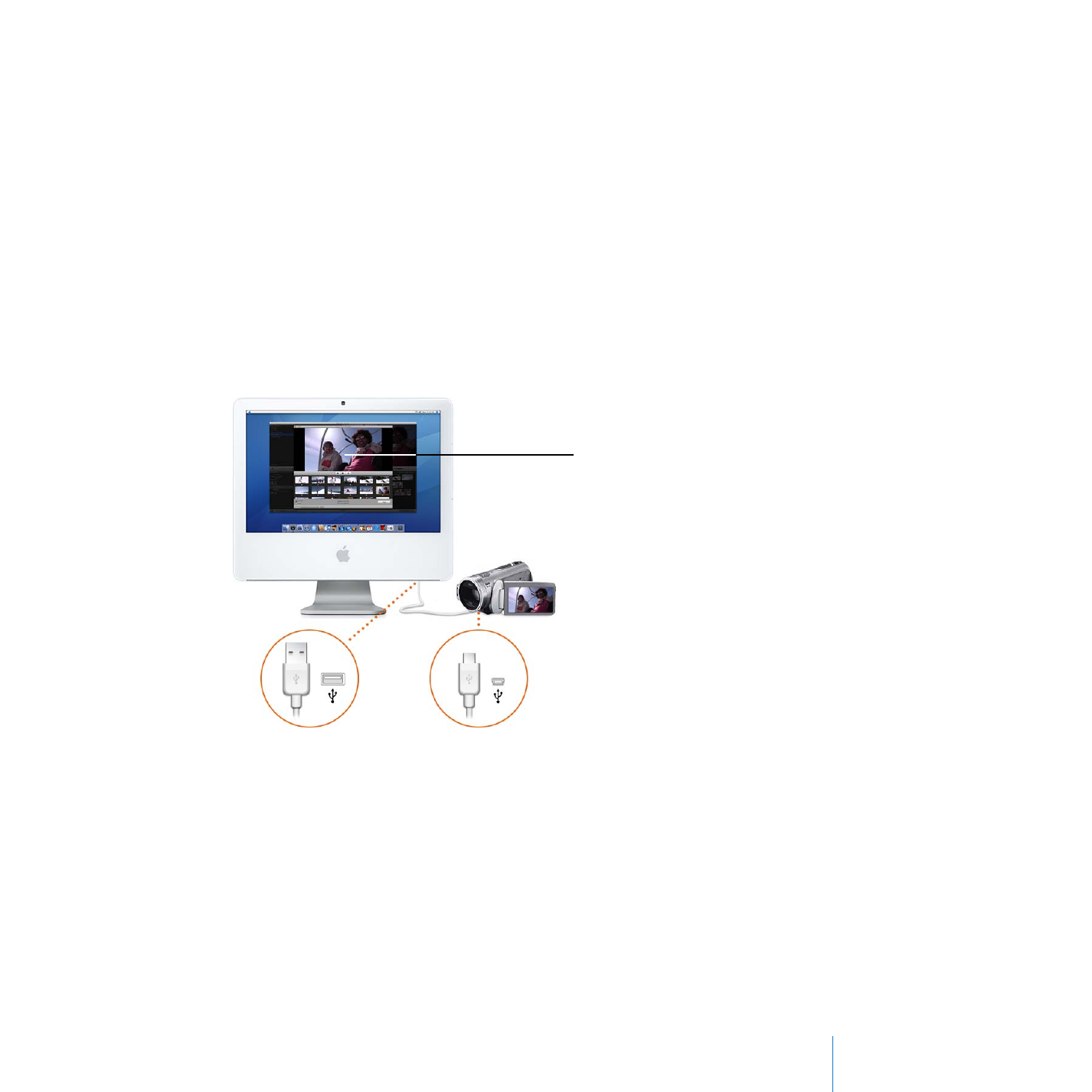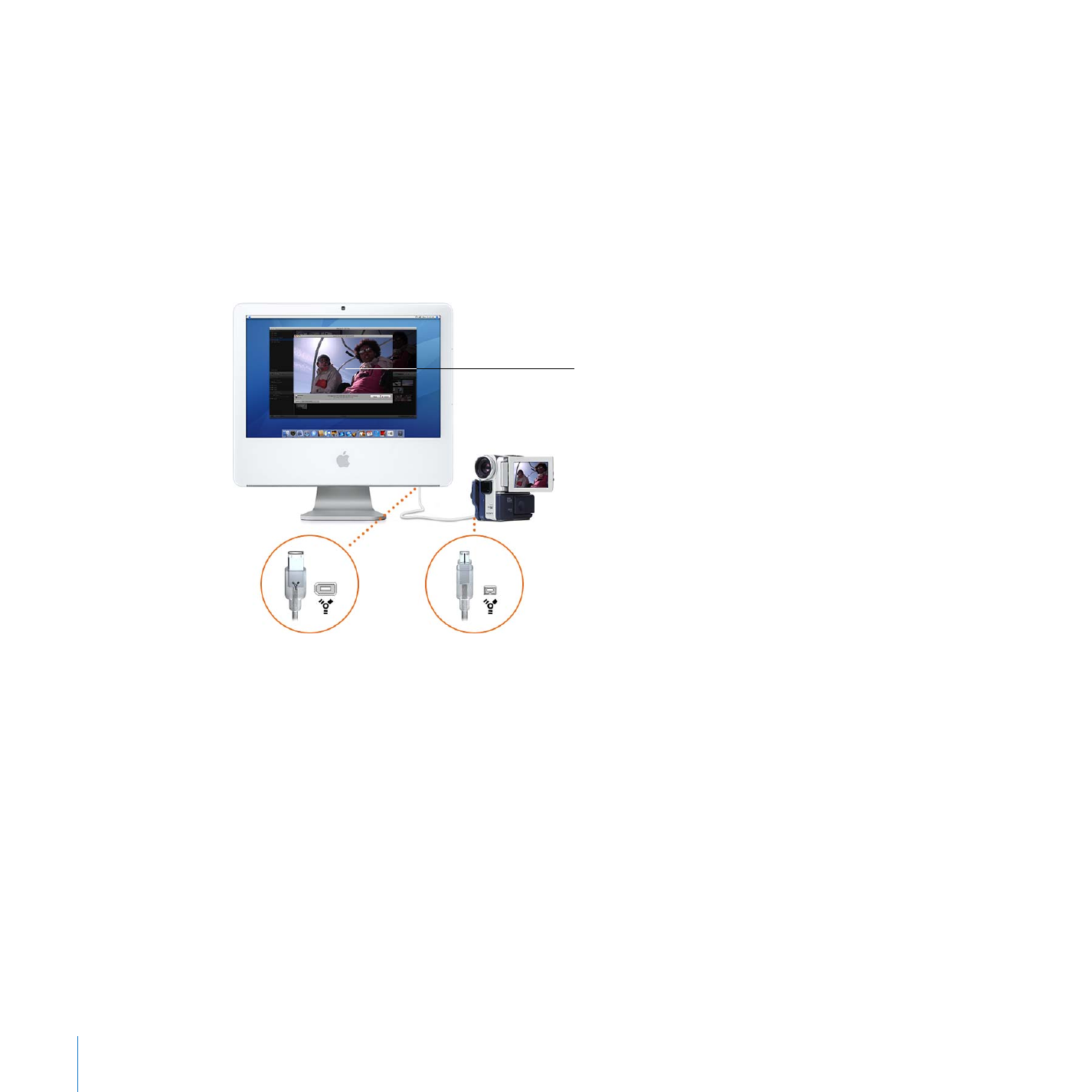
Identifying Your Camera Type and Importing Video
There are several ways to import video into iMovie. Follow the instructions that fit your
situation, and then skip to “Step 2: Organize Your Video Library and View Your Video”
on page 20.
Â
If you have a DVD, hard disk drive (HDD), or flash memory camcorder, see page 11.
Â
If your video is on tape in a FireWire-equipped digital camcorder, see page 14.
Â
If you have video in your iPhoto library, see page 16.
Â
If you want to record video directly into iMovie, see page 17.
Â
If your video is in a previous iMovie project or elsewhere on a hard disk, see page 18.
See a list of your projects
in the Project Library.
Import and edit
using the iMovie
toolbar buttons.
See a list of your Events
in the Event Library.
Browse your source video.
Build your project.
View your video in
this viewer.

Chapter 2
Learn iMovie
11
DVD, HDD, or Flash Memory Camcorders
These devices connect to your computer using a USB cable. They’re known as random-
access devices (RAD) because they allow you to select and import individual video clips
randomly, rather than having to import video while it plays through, as with a
traditional tape-based camcorder.
Note: An Intel processor is required for AVCHD video support. For more information
about AVCHD camcorders, go to www.apple.com/ilife/systemrequirements.html.
To import video from a random-access device:
1
Set the device to PC or computer mode, and then connect it to your computer using a
USB cable. (See the documentation that came with your device for specific instructions
about connecting it to a computer.)
The illustration below shows how to connect a camcorder to an iMac using a
USB cable.
When the camcorder is properly connected, the Import window opens, displaying all
the clips on the device.
The Import window opens
when your device is properly
connected.

12
Chapter 2
Learn iMovie
If you’re importing high definition (HD) video, the 1080i HD Import Setting dialog
opens. If you’re not importing 1080i format video, just click OK. If you are importing
1080i format, or if you will do so in the future, select the size in which you want iMovie
to import your video. The Large size video is recommended for most ordinary uses
(including viewing on Apple TV) because it saves hard disk space and may play back
more smoothly on some computers. However, if your camcorder records in true 1920
by 1080 HD video, and if you will use this video for broadcasting or exporting to
Final Cut Pro, select the Full size, which better preserves the original quality of the
video but uses more disk space. (For more detailed information about this, search for
1080i in iMovie Help.)
Note: If you’re using a DVD camcorder, plugging it into your Mac may cause DVD Player
to open. If that happens, simply close DVD Player.
2
Click Import All to import all the clips.
3
From the Save To pop-up menu, choose a disk where you want to store the imported
video.
You can choose any supported hard disk that’s connected to your computer with a
FireWire cable. It takes about 13 GB to store an hour of standard definition (DV) video
and 40 GB to store an hour of high definition (HD) video, so make sure you have
enough space on the disk you choose. The amount of free space on each available disk
is shown in parentheses next to the disk’s name in the pop-up menu.
4
Choose how you want to organize the imported video in your Event Library:
 To add the imported video to an already existing Event, select “Add to existing
Event,” and then choose its name from the pop-up menu.
 To create a new Event, type a name for it in the “Create new Event” field (for example,
“Birthday Party”). If you want to create a new Event for each day on which the video
was recorded, select “Split days into new Events.”
5
If you’re importing 1080i-format video, make a size selection from the pop-up menu.
Large size video is of high enough quality to view on a high definition television
(HDTV) and for most other uses. However, if you’ll be exporting your movie to
Final Cut Pro, or if you have some other reason to maintain the original, full size of
your video, choose “Full - 1920 x 1080” from the “Import 1080i video as” pop-up menu.
6
Click OK.
It can take from several minutes to more than an hour for iMovie to import the video
and generate thumbnail images of each clip, depending on how many minutes of
video you have. The progress bars in the Import window indicate which clip is currently
being imported and how quickly the import is proceeding.

Chapter 2
Learn iMovie
13
7
When the video is finished importing, turn off your camcorder and disconnect it from
your computer.
Selectively Importing Video from a Random-Access Device
If you don’t want to import the entire contents of your device, you can selectively
import only the video clips that you want. You can use the playback controls below
the viewer in the Import window to review the clips and decide which clips to
import. For this tutorial, it’s best to import at least 10 or 15 minutes of video to
work with.
After connecting your device to your computer as described above, do one of the
following.
To import most of the video clips:
1
Set the switch on the left side of the Import window to Manual.
2
Deselect the checkboxes below the clips you don’t want to import.
3
Click Import Checked.
4
Continue with steps 3 through 6, beginning on page 12.
To import only a few of the video clips:
1
Set the switch on the left side of the Import window to Manual.
2
Click Uncheck All.
3
Select the checkboxes below the clips you want to import.
4
Click Import Checked.
5
Continue with steps 3 through 6, beginning on page 12.
When the video is finished importing, click the Eject button next to the Camera pop-
up menu, and then turn off your camcorder and disconnect it from your computer.

14
Chapter 2
Learn iMovie
FireWire-Equipped Digital Camcorders
If you have a DV or HDV mini-DV camcorder that you can connect to your computer
using a FireWire cable, you’ll import the video as it plays through on the tape.
To import video from a camcorder with a FireWire connection:
1
Set the camcorder to VTR mode (video tape recorder mode, which some camcorders
call “Play” or “VCR” mode) and turn it on, if it does not turn on automatically.
2
Connect your camcorder to your computer using a FireWire cable.
The illustration below shows how to connect a camcorder to an iMac using a
FireWire cable.
When the camera is properly connected, the Import window opens.
If you’re importing high definition (HD) video, the 1080i HD Import Setting dialog
opens. If you’re not importing 1080i format video, just click OK. If you are importing
1080i format, or if you will do so in the future, select the size in which you want iMovie
to import your video. The Large size video is recommended for most ordinary uses
(including viewing on Apple TV) because it saves hard disk space and may play back
more smoothly on some computers. However, if your camcorder records in true 1920
by 1080 HD video, and if you will use this video for broadcasting or exporting to
Final Cut Pro, select the Full size, which better preserves the original quality of the
video but uses more disk space. (For more detailed information about this, search for
1080i in iMovie Help.)
3
Make sure the switch on the left side of the window is set to Automatic.
4
Click Import.
The Import window opens
when your device is properly
connected.

Chapter 2
Learn iMovie
15
5
From the Save To pop-up menu, choose a disk where you want to store the
imported video.
You can choose any supported hard disk that’s connected to your computer with a
FireWire cable. It takes about 13 GB to store an hour of standard definition (DV) video
and 40 GB to store an hour of high definition (HD) video, so make sure you have
enough space on the disk you choose. The amount of free space on each available disk
is shown in parentheses next to the disk’s name in the pop-up menu.
6
Choose how you want to organize the imported video in your Event Library:
 To add the imported video to an already existing Event, select “Add to existing
Event,” and then choose its name from the pop-up menu.
 To create a new Event, type a name for it in the “Create new Event” field (for example,
“Birthday Party”). If you want to create a new Event for each day on which the video
was recorded, select “Split days into new Events.”
7
If you’re importing 1080i-format video, make a size selection from the pop-up menu.
Large size video is of high enough quality to view on a high definition television
(HDTV) and for most other uses. However, if you’ll be exporting your movie to
Final Cut Pro, or if you have some other reason to maintain the original, full size of
your video, choose “Full - 1920 x 1080” from the “Import 1080i video as” pop-up menu.
8
Click OK.
The tape in your camcorder automatically rewinds to the beginning; all the video on
the tape will be imported, and then the tape rewinds again.
The tape plays as it’s imported. You can watch the video as it plays (the audio plays
only through the camcorder) or leave your computer and let the importing continue
while you’re away. It can take longer to import the video than it takes to watch it.
After importing, iMovie takes some minutes to generate thumbnail images of each
video clip.

16
Chapter 2
Learn iMovie
9
When the video is finished importing, you can turn off your camcorder and disconnect
it from your computer.
Video in Your iPhoto Library
Video from your digital still camera or camera phone that you download to your
iPhoto library is automatically available when you open iMovie. In the Event Library,
select iPhoto Videos, and then select the Event you want. (For detailed information
about adding video to your iPhoto library, open the iPhoto application and refer to
iPhoto Help.)
Note: Only video formats compatible with iMovie will appear in your Event Library.
Selectively Importing Video from a FireWire Camcorder
If you don’t want to import the entire contents of your tape, you can selectively
import only the moments you want. For this tutorial, it’s best to import at least 10
or 15 minutes of video to work with.
After connecting your camcorder to your computer as described above, do the
following.
To selectively import video:
1
Set the switch on the left side of the Import window to Manual.
2
Use the playback controls in the Import window to rewind, fast-forward, and review
your tape.
After you’ve reviewed your video, rewind the tape to the point where you want to
start importing.
3
Click Import, and then continue with steps 5 through 8, beginning on page 15.
The video begins importing from the point where you had queued it.
4
Click Stop when you want to stop importing. Each time you stop importing, iMovie
takes a few minutes to generate thumbnail images of your imported video.
5
To import additional video, repeat steps 2 through 4, above.
6
When you’re finished importing video, you can turn off your camcorder and
disconnect it from your computer.

Chapter 2
Learn iMovie
17
Recording Video Directly into iMovie
If your Mac has a built-in iSight camera, or if you connect an iSight or other compatible
web camera or camcorder with a FireWire cable, you can record video directly into
iMovie and work with it.
To record directly into iMovie:
1
Connect your iSight if it’s not built in (or your other web camera or FireWire-equipped
camcorder.)
2
Click the Import button to open the Import window.
3
If you have more than one device connected to your computer, choose the camera you
want to use from the Camera pop-up menu.
4
Click Capture.
5
From the Save To pop-up menu, choose a disk where you want to store the recorded
video.
You can choose any supported hard disk that’s connected to your computer with a
FireWire cable. It can take several GB of space to store one hour of video, so make sure
you have enough space on the disk you choose. The amount of free space on each
available disk is shown in parentheses next to the disk’s name in the pop-up menu.
6
Choose how you want to organize the recorded video in your Event Library:
 To create a new Event with the recorded video, type a name for it in the “Create new
Event” field (for example, “Birthday Party”).
 To add the recorded video to an already existing Event, select “Add to Existing Event,”
and then choose its name from the pop-up menu.
7
When you’re ready to begin recording, click OK. iMovie begins to record immediately.
8
To stop recording, click Stop anytime.
You can start and stop recording as often as you like. Each time you stop recording,
iMovie takes a few moments to generate thumbnail images representing the video.
Each time you start recording again, you can create a new Event, or click OK to
continue adding the new video to the same Event.
9
When you’re finished recording, click Done.
Import button

18
Chapter 2
Learn iMovie
iMovie HD Projects or Other Movie Files on Your Hard Disk
You can import the video that you’ve already stored on your computer’s hard disk, or
on any supported external hard disk connected to your computer with a FireWire cable.
To import video from a hard disk:
1
Choose File > Import Movies, and then locate the project in the Import window.
If you’re importing high definition (HD) video, the 1080i HD Import Setting dialog
opens. If you’re not importing 1080i format video, just click OK. If you are importing
1080i format, or if you will do so in the future, select the size in which you want iMovie
to import your video. The Large size video is recommended for most ordinary uses
(including viewing on Apple TV) because it saves hard disk space and may play back
more smoothly on some computers. However, if your camcorder records in true 1920
by 1080 HD video, and if you will use this video for broadcasting or exporting to
Final Cut Pro, select the Full size, which better preserves the original quality of the
video but uses more disk space. (For more detailed information about this, search for
1080i in iMovie Help.)
2
Choose a disk where you want to save the recording in the Save To pop-up menu.
You can choose any supported hard disk that’s connected to your computer with a
FireWire cable. It can take several GB of space to store one hour of video, so make sure
you have enough space on the disk you choose. The amount of free space on each
available disk is shown in parentheses next to the disk’s name in the pop-up menu.
3
Choose how you want to organize the imported video in your Event Library:
 To create a new Event with the imported video, type a name for it in the Event Name
field (for example, “Birthday Party”).
 To add the imported video to an existing Event, select “Existing Event” and then
choose its name from the pop-up menu.
4
If you’re importing 1080i-format video, make a size selection from the pop-up menu.
Large size video is of high enough quality to view on a high definition television
(HDTV) and for most other uses. However, if you’ll be exporting your movie to
Final Cut Pro, or if you have some other reason to maintain the original, full size of
your video, choose “Full - 1920 x 1080” from the “Import 1080i video as” pop-up menu.
5
Choose what to do with the original files:
 To delete the original files after they’ve been copied into iMovie, select “Move files.”
 To keep the original files intact even after they’ve been copied into iMovie, select
“Copy files.”

Chapter 2
Learn iMovie
19
6
Click Import.
You can also import video from a project created in iMovie HD. When you import an
iMovie HD project, only the video that was originally imported from a camcorder into
the project is imported into iMovie; any video that was dragged into the project from
the Finder is not imported. The clips in the clip viewer are added to the video library
and grouped as an Event; the clips in the timeline are placed in a new iMovie project.
All transitions are replaced by cross dissolves. No titles, effects, music, sound effects, or
photos are imported into iMovie. All chapter markers are also lost.
To import a previous iMovie project:
1
Choose File > Import iMovie HD Project, and then locate it in the Import dialog.
If you’re importing high definition (HD) video, the 1080i HD Import Setting dialog
opens. If you’re not importing 1080i format video, just click OK. If you are importing
1080i format, or if you will do so in the future, select the size in which you want iMovie
to import your video. The Large size video is recommended for most ordinary uses
(including viewing on Apple TV) because it saves hard disk space and may play back
more smoothly on some computers. However, if your camcorder records in true 1920
by 1080 HD video, and if you will use this video for broadcasting or exporting to
Final Cut Pro, select the Full size, which better preserves the original quality of the
video but uses more disk space. (For more detailed information about this, search for
1080i in iMovie Help.)
Typically, you’ll find your iMovie projects in your Movies folder.
2
Choose a disk where you want to save the project from the Save To pop-up menu.
You can choose any supported hard disk that’s connected to your computer with a
FireWire cable. It takes about 13 GB to store an hour of standard definition (DV) video
and 40 GB to store an hour of high definition (HD) video, so make sure you have
enough space on the disk you choose. The amount of free space on each available disk
is shown in parentheses next to the disk’s name in the pop-up menu.
3
If you’re importing 1080i-format video, make a size selection from the pop-up menu.
Large size video is of high enough quality to view on a high definition television
(HDTV) and for most other uses. However, if you’ll be exporting your movie to
Final Cut Pro, or if you have some other reason to maintain the original, full size of
your video, choose “Full - 1920 x 1080” from the “Import 1080i video as” pop-up menu.
4
Click Import.

20
Chapter 2
Learn iMovie